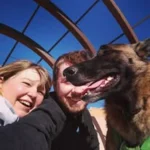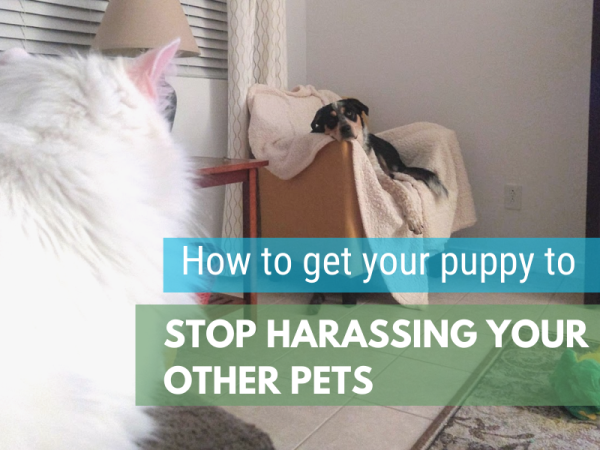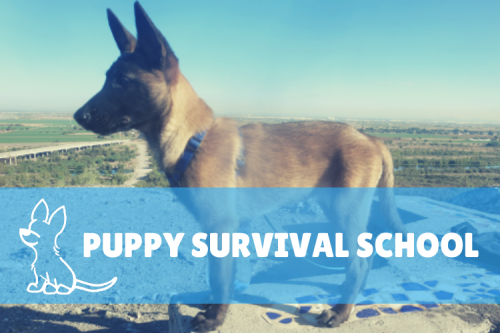Last updated: May 7, 2025
You got a puppy! Buuuuut your other pets aren’t exactly thrilled about it.
Actually, I’ll go one step further – since you’ve found your way to this article, I can almost guarantee that three things are happening to you:
- That puppy constantly wants to harass your older dog or cat. Jumping, chasing, biting their face, trying to get them to play or trying to take their food.
- The other pet is stressed out or depressed.
- You’re freaking out a little. Or a lot. Doom-spiraling about how you’ve ruined your poor beloved pet’s life, they’ll never forgive you, you were such an idiot to do this to them, you are the literal worst person in the world, etc.
Take a deep breath. We’ve seen this play out a million times, and while I can’t make any promises (seeing as how you and I have just met and all), there’s one thing I can tell you for certain:
This situation is almost never as bad or as permanent as your sleep-deprived, overstimulated brain wants you to think. There is hope.
In this article, we’ll talk about how to start improving things so that your older pets feel better, and so you can stop feeling like you have to rehome the little hellspawn ASAP.
Is it normal for puppies to never leave your other pets alone? Does this get better with time?
Yes, it’s normal for puppies to be obsessed with the other pets in the family. Just like a little kid who can’t stop pestering their cool older cousins. Puppies are naturally hyper-social and spend a ton of energy cozying up to older dogs. This is likely a hardwired survival instinct: I’m a helpless goofy wittle baby! Love me, feed me, protect me from the scary monsters in the woods beyond our den!

They have the best of intentions, but absolutely no social skills to speak of yet. That’s why they can be so maddening. I mean, what cool 13-year-old wants their annoying feral little sibling to follow them around all day?
That chaotic energy goes away with maturity. A year from now, your puppy won’t be mobbing your older dog every chance they get.
And it’s normal for the resident pet to be a bit thrown off and stressed out over having their predictable routine blown to smithereens. They need time for their own new puppy adjustment period, just like you do.
But you do have to be intentional about what happens over the next few months. If these animals are always having negative interactions, that will shape how they feel about each other in the long run.
What to watch out for
Something has to change if:
- The other pets can’t just live their life without being terrorized.
- The older dog has started spending all their time on the couch, or the cat spends all their time under the bed, because that’s the only way to steer clear of puppy teeth.
- The older dog is giving physical corrections to the puppy (snapping, snarling, pinning them) more than once in the bluest of moons.
- The dogs are fighting over resources like toys, beds, food, etc.
- The cat is being put in a position where they have to defend themselves (swatting or biting the puppy).
- The puppy is afraid of the cat or older dog.
Yes, with time, puppies get less… zealous. With time, most resident pets can adjust to the changes in their routine.
But simmering tension doesn’t magically disappear.
So if anything on that list sounds familiar, it’s important to intervene now. I’m not trying to fearmonger here; there’s a lot you can do to turn things around. And now is a good time start, because this kind of thing is much easier to modify while your pup is still a hyper-social, agreeable little baby.
Five steps to bring some peace into your multi-pet household

In this guide, I’ll teach you some of the pieces from the bigger plan we teach in our program. I chose these because they can start giving you some relief right away, and they’re simple to implement without needing any foundation skills.
This should be enough to get you a little breathing room, a little peace of mind, and a glimpse of the light at the end of the tunnel.
Step 1. Create space for the older dog or cat to relax
You’ll start seeing less conflict and stress if your older pet has guaranteed safe areas where the puppy can’t reach them.
A lot of people make the mistake of letting their puppies have too much access to the other pets. And I get it. You’re eager for everyone to be friends, and you want the whole family to be be able to hang out together.
That’s a great goal, but it’s just that – a goal. Something to work towards.
If your pup has unlimited freedom, they just rehearse the same bad habits over and over. And the older pet never gets to let their guard down. That’s a recipe for long-term resentment, not a peaceful household.
Should you just let them work it out themselves?
The short answer is no, definitely not. But I get why you might think that. I struggled with this question with my first “pack,” the original three lost dogs.
Sixteen years and numerous battle scars later, I get a bit, shall we say, triggered when I hear this advice given to poor unsuspecting puppy parents.
Sure, sometimes people do get lucky with the let-them-work-it-out approach, which is why you might see some guy on Reddit giving advice that’s like “just let the adult dog show the puppy whose boss. My puppy harassed my adult dog until one day the adult dog beat him up and they’ve been fine ever since.”
But that’s not a gamble I would take ever again, personally.
Because now as a dog trainer, I get a front row seat to all the times that approach goes horribly (HORRIBLY) wrong – when all the drama could have been avoided with some pretty simple and easy precautions.

What to do
Use baby gates, exercise pens, crates, leashes, and/or separate rooms to manage interactions. Give the older pet regular breaks where they can move freely and relax without getting pounced on. If possible, give them designated puppy-free areas of the home where they can go to escape. Make sure they have their own bed, bowls, and toys that the puppy isn’t allowed to use.
Step 2. Meet your puppy’s needs for exercise, mental stimulation, and enrichment (the right way)
This can directly reduce how much they annoy your other pets. It also helps indirectly: by meeting their needs before you work on the training stuff we’ll talk about later, it increases the odds that training will be successful.
When it comes to exercise, think Goldilocks: not too much, not too little.
You’ve heard the old saying “a tired dog is a good dog,” but we find “a tired puppy is a wired puppy” to be more accurate.
Too much exercise can make puppies overtired and cranky. Just like a three year old who spends a couple hours running around Disneyland, getting more and more hyperactive until suddenly they’re having a screaming meltdown in front of Mickey and Minnie.
So we gotta be smart about it: One of the first things we do with all our training students is help them find the right activities and routines to help their puppies be calm instead of more crazy.
The best place to start? Pick activities that make them think. Forget fetch – nothing tires a dog out more effectively than putting their brains to work. This is true of all dogs, but especially young puppies.
And the thing is, if you want your pup to grow up to become the most well-mannered, stable adult he can be, he needs lots of socialization and training. So you should be putting his brain to work anyway.

How to wear out (and develop!) your puppy’s brain
Feed Chomper some of her meals in puzzle toys.
Teach her some tricks and important obedience cues like sit or come when called.
Have her forage for food or play indoor agility.
Set up a play date with a puppy-owning friend or neighbor, if you’re lucky enough to have one. Chomper will get an outlet for her natural play behavior and get to practice communication with her own species, a skill that many pet dogs are sorely lacking.
Take Chomper on puppy adventures, which are our favorite way to train, socialize, and bond with our puppies.
A couple hours a day of exploration, learning, and working for her food will work wonders. She’ll be less likely to take her boredom out on the cat.
Plus, she’ll grow up to be a mentally stable dog. I don’t know about you, but I do like my dogs to be mentally stable.
Step 3. Eliminate conflict hot spots as much as reasonably possible

In most cases, especially once the puppy’s enrichment needs are met, conflict doesn’t happen literally constantly. It happens at specific, predictable moments.
If you could say “my puppy attacks my dog/cat whenever [blank],” that’s one of the hot spots I’m talking about.
When many of our students first start working with us, they’ve been letting these same situations play out again and again, hoping the puppy will eventually learn. But the puppy is basically just getting in a lot of practice at being super annoying. And the older pet is getting more upset.
What to do
Make a list of all the hot spots you can think of. Then either prevent them (for now), or structure them differently so your puppy learns a calmer pattern.
Some examples:
Hot spot: “In the morning, my puppy jumps on my adult dog when I open the back door to let them all out to pee.”
Fix: Let the older dog out first, while puppy stays in their crate a little longer.
Hot spot: “When we come home from a walk, my now-energized puppy runs in and body slams the cat.”
Fix: Keep the pup on leash when you enter the house, and take them straight into their pen with a chew for twenty minutes post-walk to settle down.
Even when you’re being careful and keeping the pets physically separate, hot spots can appear:
Hot spot: “We keep the puppy in the living room, with a baby gate across the door to the hall. But the cat has to walk past the baby gate to use the litter box. The puppy rushes the gate, barks, and scares the cat every time.”
Fix: Can you put a blanket over the baby gate, so Chomper can’t see the cat?
Hot spot: “My dogs all eat dinner in the same area, with the puppy safely in her crate. She finishes her food quickly and then barks like mad at the others while they’re still eating.”
Fix: Time to feed the puppy in a separate area, so your adult dog can eat their food in peace.
That last hot spot comes from an aggression case we’re working on at the moment. This happened repeatedly in the “honeymoon” period before the resident adult dog began biting the new puppy pretty severely. I’m not saying this was the direct cause of that aggression, as aggression is more complex than that. But it definitely didn’t help.
Step 4. Do structured training setups where you teach the puppy how you want them to behave around the other pets
When you’ve gotten your enrichment and management plan locked down, your puppy should be in a place where he can start learning better ways to behave when his favorite celebrity (aka your dog or cat) graces him with their presence.
A mistake most people make: Only managing or correcting the annoying behavior without teaching an alternative. This leaves the puppy confused and the behavior keeps coming back.
What to do
Start with a simple training activity, in a controlled practice setting. Do this when Chomper is in a relatively chill mood, maybe after getting some energy out with enrichment activities.
Keep Chomper on leash, and bring him into an indoor area where he can see the other pet, but not reach them.
As soon as he looks towards the other pet, but before he starts going after them, say “yes!” and stick a high-value treat right in front of his nose.
When he’s chewing that treat, he’ll probably be too busy to start doing anything obnoxious. Look at that, another opportunity to reward good behavior! Stick another treat in front of his nose.
You get the idea – you’re basically creating a situation where you’re setting him up for success and rewarding good behavior before he has a chance to do any annoying behavior. If you do it right, this should lead to him doing more of the behavior you like, and giving you more things to reinforce.
Reward any and all behavior you like during these sessions, such as:
- Sitting
- Lying down
- Sniffing the cat without attacking her
- Looking away from the cat to you
- Walking away from the cat
(We have a detailed step-by-step video tutorial for this kind of training in Puppy Survival School)
Step 5. Remember to catch your puppy in the act… of doing what you want

Even outside of structured training, I’m willing to bet there are at least some times where Chomper actually does something totally appropriate, like quietly watching the cat walk by, but no one acknowledges it. So he has no idea that was a good choice. And next time, he goes back to jumping.
Totally understandable – we all have busy lives and don’t always notice the quiet, good things our dogs do. But if you only respond to the “bad” stuff and ignore the good, your puppy misses the chance to learn what does work.
What to do
Start noticing and rewarding the moments when your puppy is doing something you like. Especially the boring stuff: calmly lying down, sitting and watching the other pet, or just choosing to ignore them. You don’t have to throw a party every time. Just toss a treat or calmly praise them to let them know they’re on the right track.
If you’d like more guidance on implementing all of this within the dynamic of your specific pets, we can help you out in Puppy Survival School. We’ll teach you the complete framework for raising a puppy who listens, can chill out, and fits nicely into your family – even if things feel messy and overwhelming right now.




